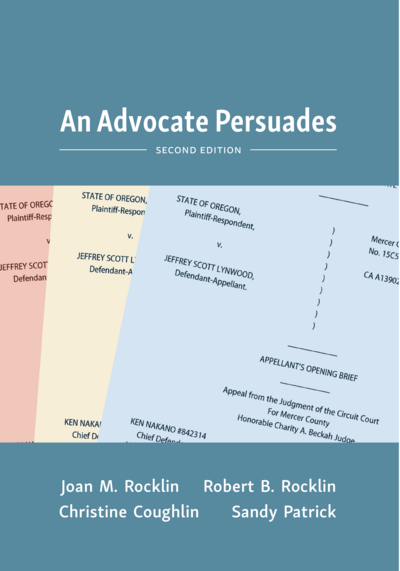Click here to view a side by side comparison of the first and second editions.
The second edition of An Advocate Persuades is reorganized into four parts: (1) Introduction to Advocacy; (2) Developing Arguments from a Persuasive Perspective; (3) Constructing Persuasive Court Documents (both at the trial and appellate level); and (4) Oral Argument (both at the trial and appellate level). The book also has an expanded appendix, which provides an overview of trial and appellate litigation in both civil and criminal cases, annotated trial and appellate briefs, and advice about moot court competitions.
The book's first part, an Introduction to Advocacy, provides an overview of the nature of persuasion generally and the core ethical standards that an advocate is required to follow.
The second part focuses on the heart of persuasive advocacy—developing persuasive arguments. This part provides easy-to-follow, step-by-step advice that students can rely on whether they are drafting a trial motion or appellate brief. The advice is provided in five chapters: Chapter 3, Organizing Claims and Arguments; Chapter 4, Themes for Persuasive Arguments; Chapter 5, Drafting Persuasive Arguments; Chapter 6, Refining Persuasive Arguments; and Chapter 7, Editing Persuasive Arguments. The content in these chapters has been significantly revised to provide detailed coverage in a practical and accessible format. The chapters incorporate lists, checklists, graphics, charts, and updated, annotated examples to aid students' understanding of the concepts and theories described.
The third part, Constructing Persuasive Court Documents, describes the court documents through which attorneys present their persuasive arguments. It starts with Chapter 8, Trial Motions & Motion Practice, which focuses on trial practice, trial court motions, and supporting memoranda. Chapter 9, Appellate Briefs & Appellate Practice, introduces readers to the world of appellate courts by explaining the appellate process, the relevant players, standards of review, and how to draft various components of the appellate brief. Finally, Chapter 10, Statements of Fact and of the Case, describes how to construct a persuasive recitation of facts, focusing on which facts to include and how to present them in the light most favorable to the drafter's client. Each chapter provides numerous annotated examples, allowing the reader to see both effective and ineffective techniques.
The fourth part, Oral Argument, now consists of five subsections designed to demystify the process of oral argument. These sections provide students the step-by-step guidance they need whether arguing before a trial or appellate court. The five sections are (1) The Purpose of Oral Argument; (2) Preparing for Oral Argument; (3) Presenting Oral Argument; (4) Trial Courts vs. Appellate Courts; and (5) Remote Oral Arguments. The newly created fifth section provides students with instruction and practical advice for presenting oral argument remotely.
The second edition of An Advocate Persuades aims to provide clear and concrete instruction about each facet of the persuasive writing and oral argument process in a logical order consistent with how an advocate will typically perform the tasks. The text's practical approach to theory, coupled with insightful examples, will enable readers to transfer their understanding to real-life legal settings. With straightforward advice, informative graphics, and an accessible layout, this text will be useful both to students in the classroom and to lawyers already in legal practice.
A teaching website for this book is available. If you are a professor, you may request the link and login information by emailing erin@cap-press.com.


